ACCT20074 Contemporary Accounting Theory: Practical Report T1
VerifiedAdded on 2023/03/30
|14
|2652
|468
Report
AI Summary
This report provides an overview of the conceptual framework for financial reporting, its history, development, and application in various countries, including the USA, UK, and Australia, under the IASB. It discusses the Australian accounting profession's concerns and academic critiques regarding the framework's quality, benefits, and limitations. The report also examines how Spotless Group Holdings Limited applies the conceptual framework. Furthermore, it compares sustainability reporting guidelines with the International Integrated Reporting Framework, analyzes the rigour of conventional accounting in sustainability reporting, and assesses the applicability of theories explaining sustainability reports. Finally, it includes an analysis of Sibanye-Stillwater Ltd's integrated reporting practices and compares them with Spotless' practices.
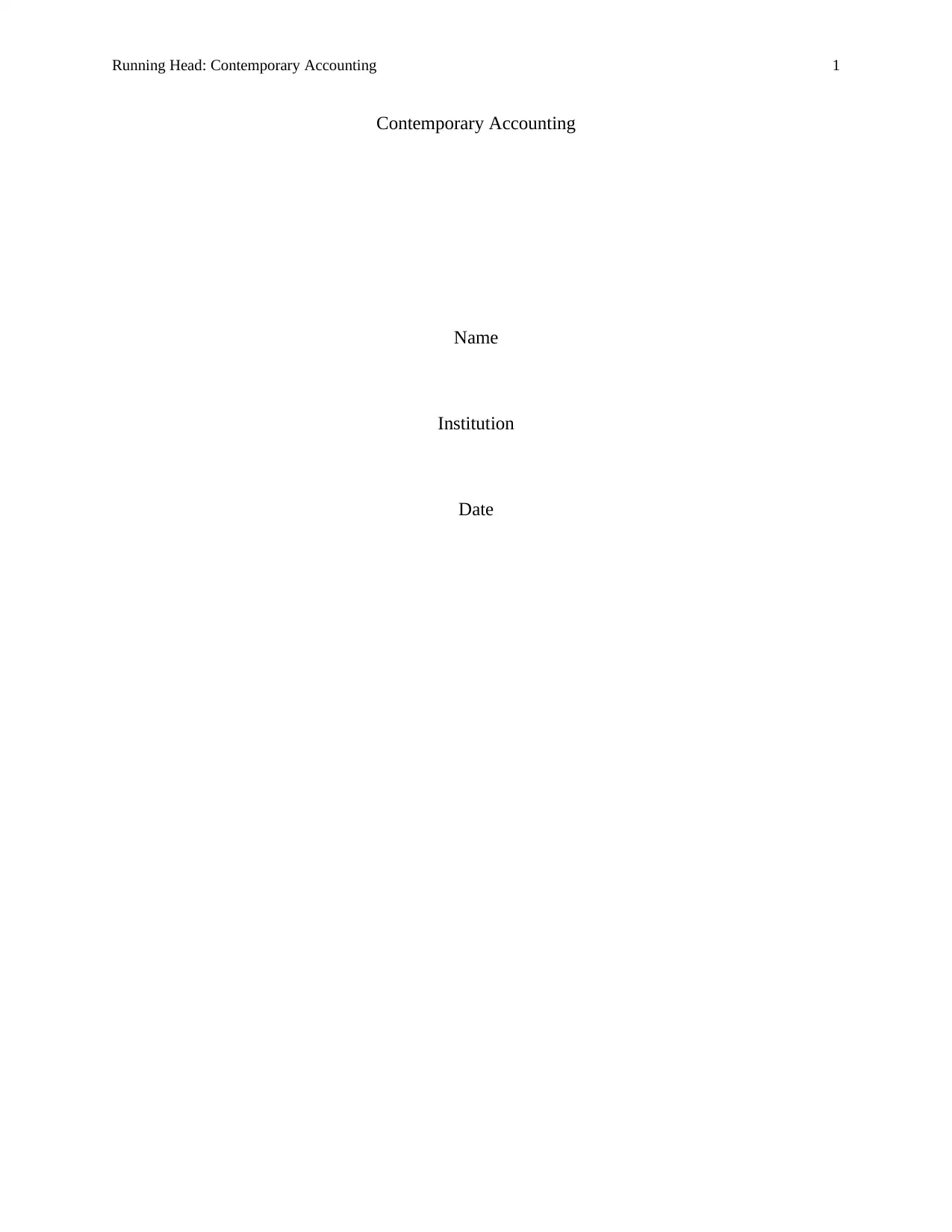
Running Head: Contemporary Accounting 1
Contemporary Accounting
Name
Institution
Date
Contemporary Accounting
Name
Institution
Date
Paraphrase This Document
Need a fresh take? Get an instant paraphrase of this document with our AI Paraphraser
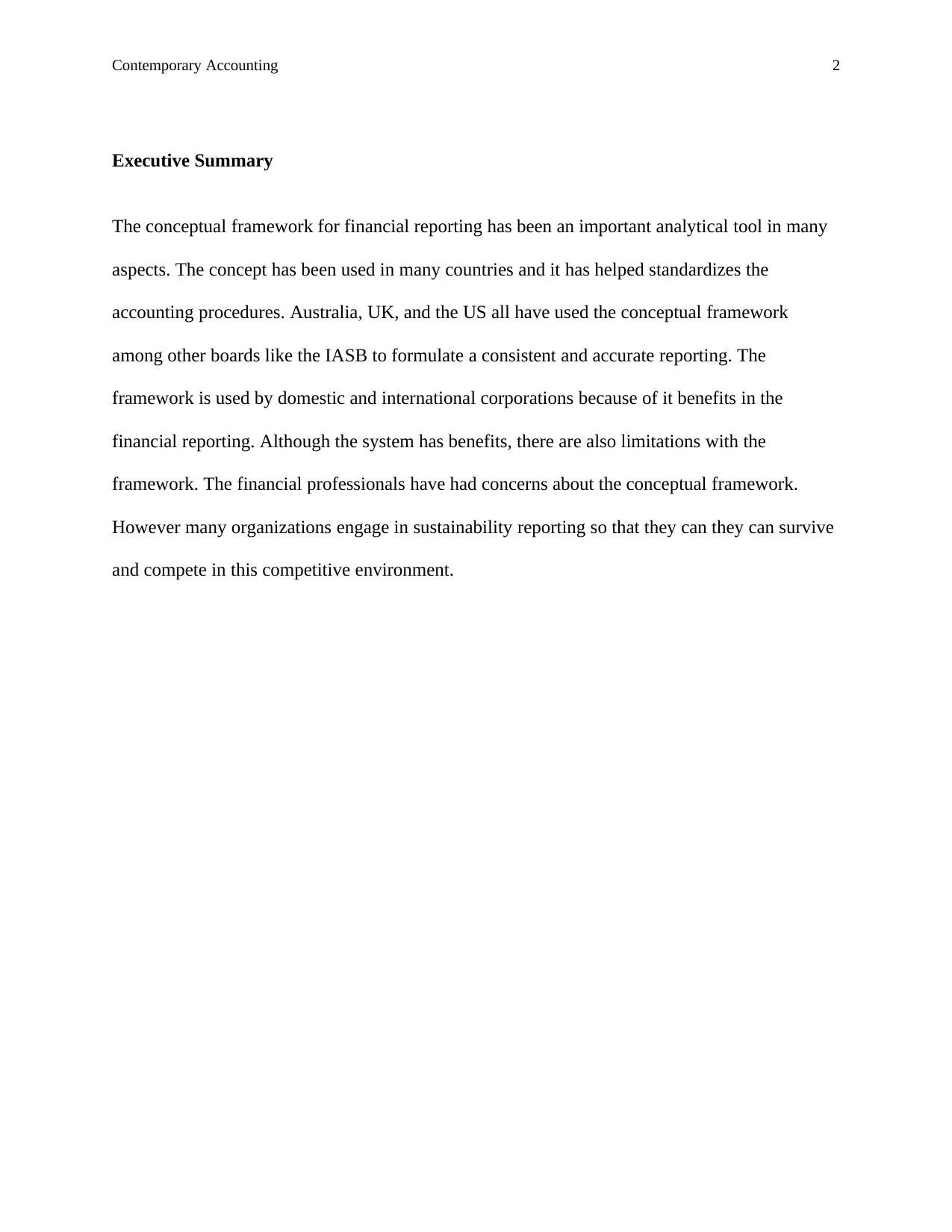
Contemporary Accounting 2
Executive Summary
The conceptual framework for financial reporting has been an important analytical tool in many
aspects. The concept has been used in many countries and it has helped standardizes the
accounting procedures. Australia, UK, and the US all have used the conceptual framework
among other boards like the IASB to formulate a consistent and accurate reporting. The
framework is used by domestic and international corporations because of it benefits in the
financial reporting. Although the system has benefits, there are also limitations with the
framework. The financial professionals have had concerns about the conceptual framework.
However many organizations engage in sustainability reporting so that they can they can survive
and compete in this competitive environment.
Executive Summary
The conceptual framework for financial reporting has been an important analytical tool in many
aspects. The concept has been used in many countries and it has helped standardizes the
accounting procedures. Australia, UK, and the US all have used the conceptual framework
among other boards like the IASB to formulate a consistent and accurate reporting. The
framework is used by domestic and international corporations because of it benefits in the
financial reporting. Although the system has benefits, there are also limitations with the
framework. The financial professionals have had concerns about the conceptual framework.
However many organizations engage in sustainability reporting so that they can they can survive
and compete in this competitive environment.
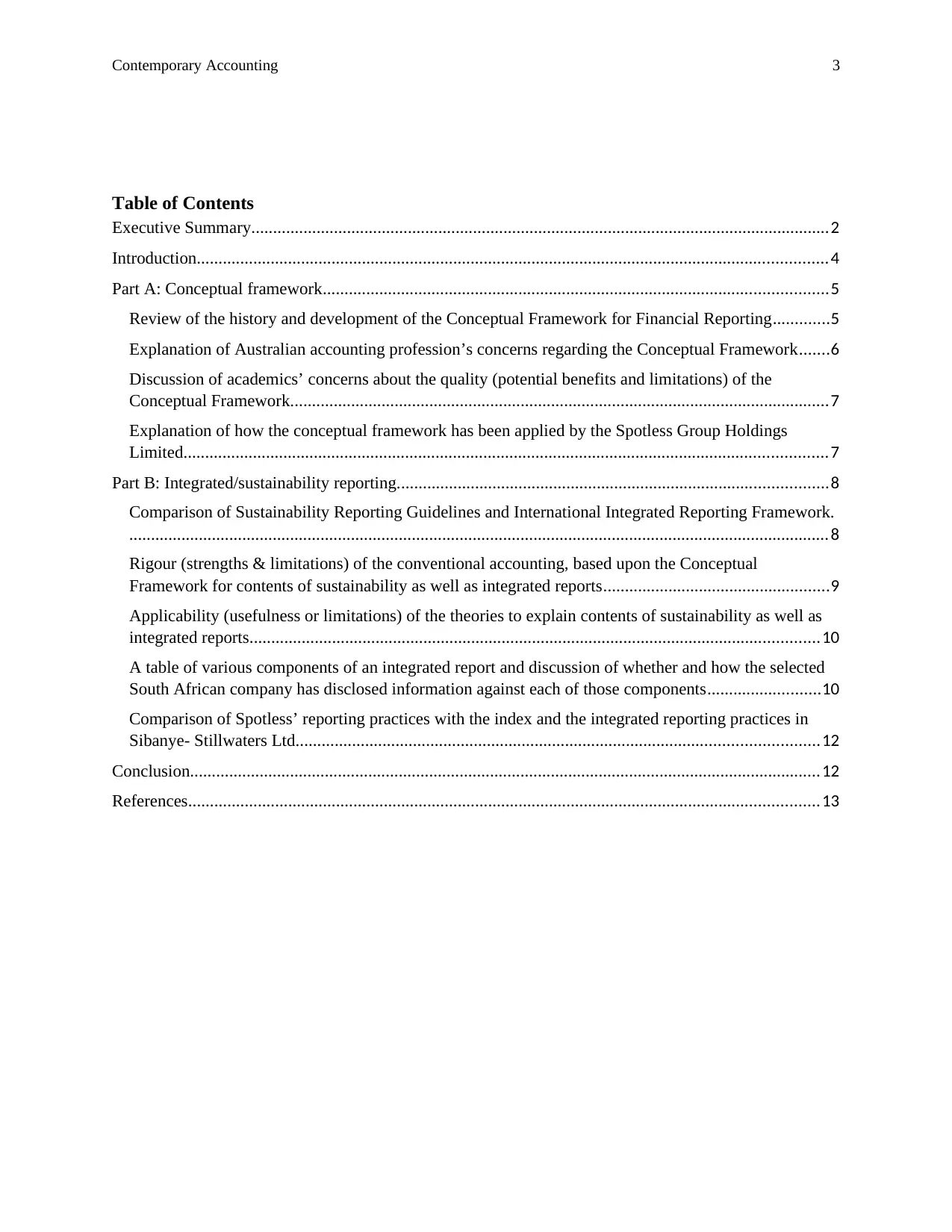
Contemporary Accounting 3
Table of Contents
Executive Summary.....................................................................................................................................2
Introduction.................................................................................................................................................4
Part A: Conceptual framework....................................................................................................................5
Review of the history and development of the Conceptual Framework for Financial Reporting.............5
Explanation of Australian accounting profession’s concerns regarding the Conceptual Framework.......6
Discussion of academics’ concerns about the quality (potential benefits and limitations) of the
Conceptual Framework............................................................................................................................7
Explanation of how the conceptual framework has been applied by the Spotless Group Holdings
Limited....................................................................................................................................................7
Part B: Integrated/sustainability reporting...................................................................................................8
Comparison of Sustainability Reporting Guidelines and International Integrated Reporting Framework.
.................................................................................................................................................................8
Rigour (strengths & limitations) of the conventional accounting, based upon the Conceptual
Framework for contents of sustainability as well as integrated reports....................................................9
Applicability (usefulness or limitations) of the theories to explain contents of sustainability as well as
integrated reports...................................................................................................................................10
A table of various components of an integrated report and discussion of whether and how the selected
South African company has disclosed information against each of those components..........................10
Comparison of Spotless’ reporting practices with the index and the integrated reporting practices in
Sibanye- Stillwaters Ltd........................................................................................................................12
Conclusion.................................................................................................................................................12
References.................................................................................................................................................13
Table of Contents
Executive Summary.....................................................................................................................................2
Introduction.................................................................................................................................................4
Part A: Conceptual framework....................................................................................................................5
Review of the history and development of the Conceptual Framework for Financial Reporting.............5
Explanation of Australian accounting profession’s concerns regarding the Conceptual Framework.......6
Discussion of academics’ concerns about the quality (potential benefits and limitations) of the
Conceptual Framework............................................................................................................................7
Explanation of how the conceptual framework has been applied by the Spotless Group Holdings
Limited....................................................................................................................................................7
Part B: Integrated/sustainability reporting...................................................................................................8
Comparison of Sustainability Reporting Guidelines and International Integrated Reporting Framework.
.................................................................................................................................................................8
Rigour (strengths & limitations) of the conventional accounting, based upon the Conceptual
Framework for contents of sustainability as well as integrated reports....................................................9
Applicability (usefulness or limitations) of the theories to explain contents of sustainability as well as
integrated reports...................................................................................................................................10
A table of various components of an integrated report and discussion of whether and how the selected
South African company has disclosed information against each of those components..........................10
Comparison of Spotless’ reporting practices with the index and the integrated reporting practices in
Sibanye- Stillwaters Ltd........................................................................................................................12
Conclusion.................................................................................................................................................12
References.................................................................................................................................................13
⊘ This is a preview!⊘
Do you want full access?
Subscribe today to unlock all pages.

Trusted by 1+ million students worldwide
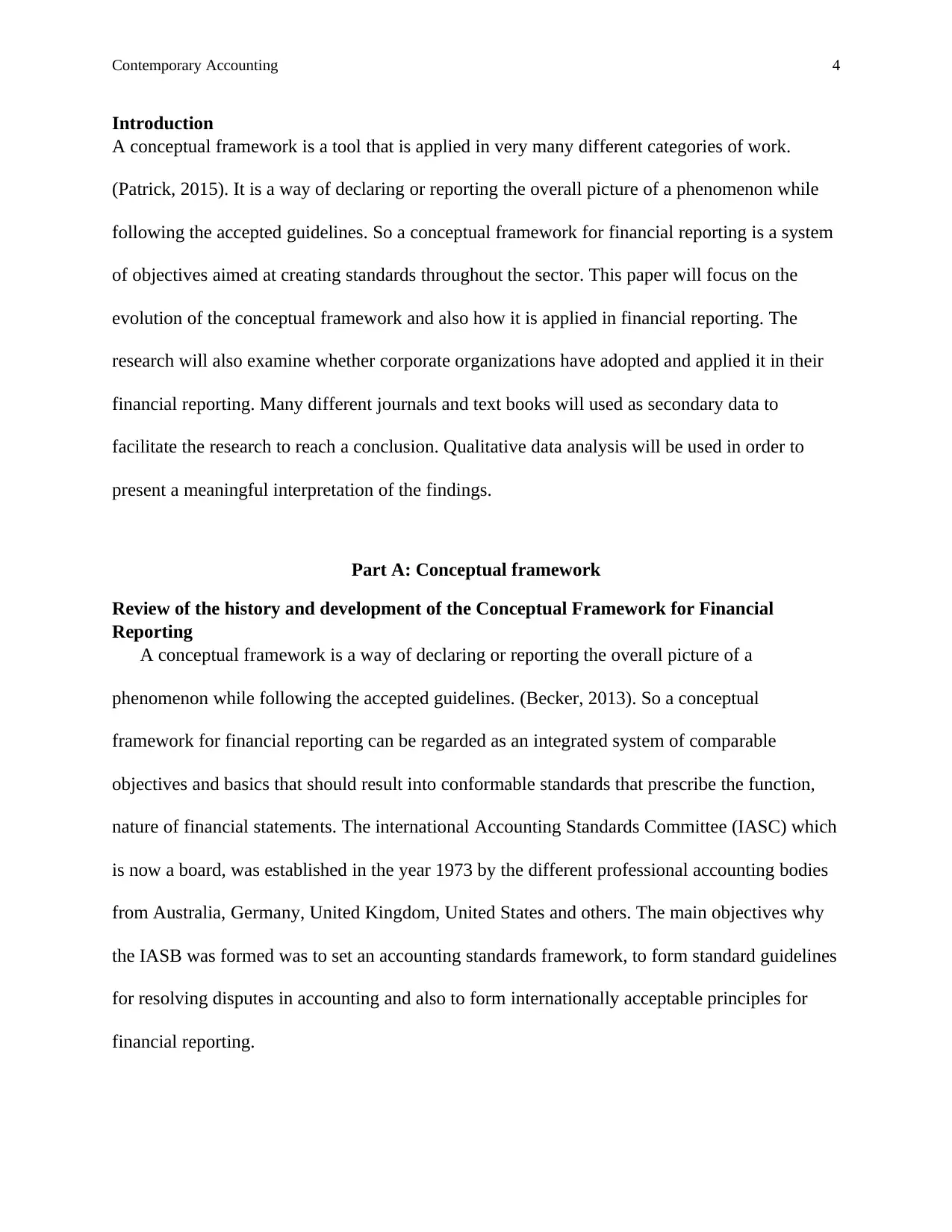
Contemporary Accounting 4
Introduction
A conceptual framework is a tool that is applied in very many different categories of work.
(Patrick, 2015). It is a way of declaring or reporting the overall picture of a phenomenon while
following the accepted guidelines. So a conceptual framework for financial reporting is a system
of objectives aimed at creating standards throughout the sector. This paper will focus on the
evolution of the conceptual framework and also how it is applied in financial reporting. The
research will also examine whether corporate organizations have adopted and applied it in their
financial reporting. Many different journals and text books will used as secondary data to
facilitate the research to reach a conclusion. Qualitative data analysis will be used in order to
present a meaningful interpretation of the findings.
Part A: Conceptual framework
Review of the history and development of the Conceptual Framework for Financial
Reporting
A conceptual framework is a way of declaring or reporting the overall picture of a
phenomenon while following the accepted guidelines. (Becker, 2013). So a conceptual
framework for financial reporting can be regarded as an integrated system of comparable
objectives and basics that should result into conformable standards that prescribe the function,
nature of financial statements. The international Accounting Standards Committee (IASC) which
is now a board, was established in the year 1973 by the different professional accounting bodies
from Australia, Germany, United Kingdom, United States and others. The main objectives why
the IASB was formed was to set an accounting standards framework, to form standard guidelines
for resolving disputes in accounting and also to form internationally acceptable principles for
financial reporting.
Introduction
A conceptual framework is a tool that is applied in very many different categories of work.
(Patrick, 2015). It is a way of declaring or reporting the overall picture of a phenomenon while
following the accepted guidelines. So a conceptual framework for financial reporting is a system
of objectives aimed at creating standards throughout the sector. This paper will focus on the
evolution of the conceptual framework and also how it is applied in financial reporting. The
research will also examine whether corporate organizations have adopted and applied it in their
financial reporting. Many different journals and text books will used as secondary data to
facilitate the research to reach a conclusion. Qualitative data analysis will be used in order to
present a meaningful interpretation of the findings.
Part A: Conceptual framework
Review of the history and development of the Conceptual Framework for Financial
Reporting
A conceptual framework is a way of declaring or reporting the overall picture of a
phenomenon while following the accepted guidelines. (Becker, 2013). So a conceptual
framework for financial reporting can be regarded as an integrated system of comparable
objectives and basics that should result into conformable standards that prescribe the function,
nature of financial statements. The international Accounting Standards Committee (IASC) which
is now a board, was established in the year 1973 by the different professional accounting bodies
from Australia, Germany, United Kingdom, United States and others. The main objectives why
the IASB was formed was to set an accounting standards framework, to form standard guidelines
for resolving disputes in accounting and also to form internationally acceptable principles for
financial reporting.
Paraphrase This Document
Need a fresh take? Get an instant paraphrase of this document with our AI Paraphraser
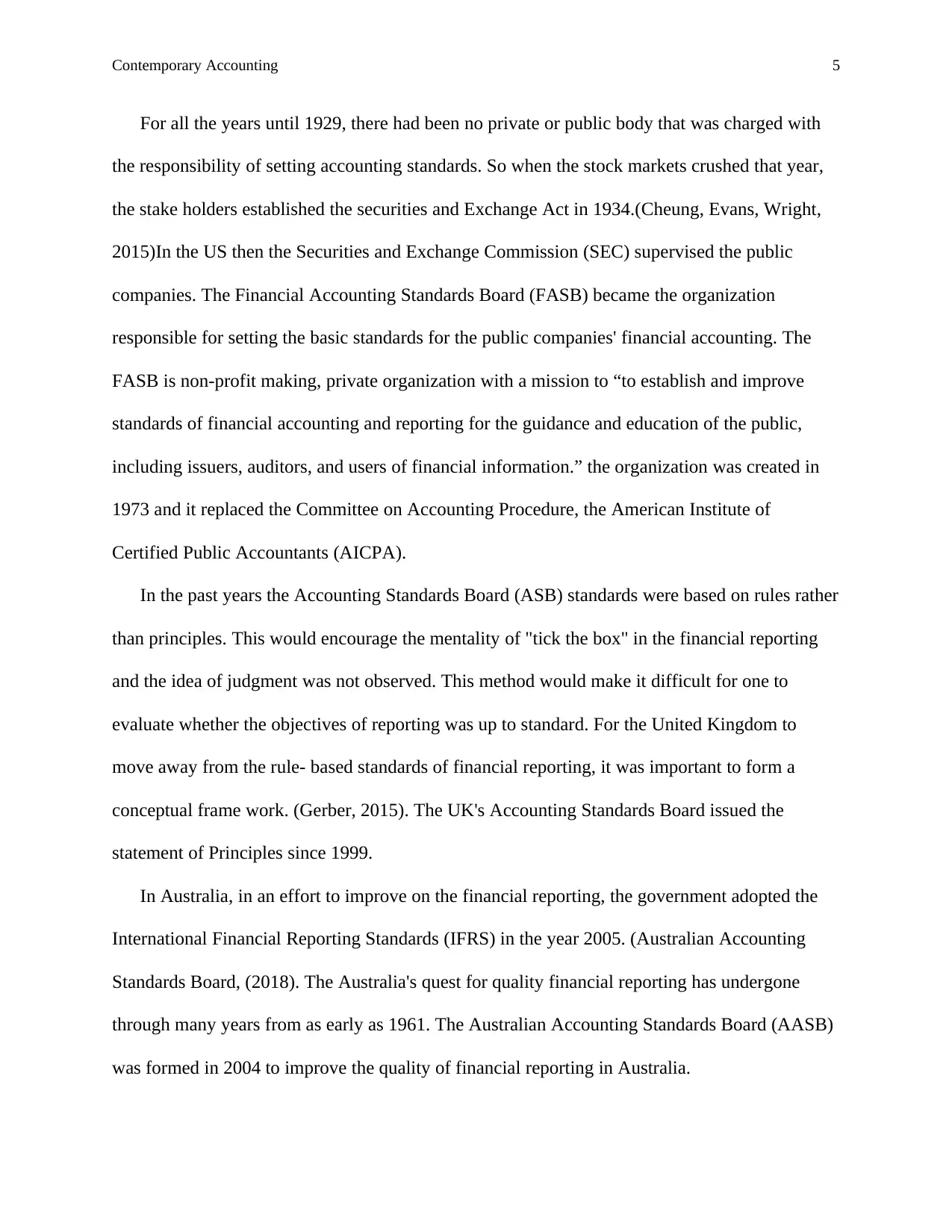
Contemporary Accounting 5
For all the years until 1929, there had been no private or public body that was charged with
the responsibility of setting accounting standards. So when the stock markets crushed that year,
the stake holders established the securities and Exchange Act in 1934.(Cheung, Evans, Wright,
2015)In the US then the Securities and Exchange Commission (SEC) supervised the public
companies. The Financial Accounting Standards Board (FASB) became the organization
responsible for setting the basic standards for the public companies' financial accounting. The
FASB is non-profit making, private organization with a mission to “to establish and improve
standards of financial accounting and reporting for the guidance and education of the public,
including issuers, auditors, and users of financial information.” the organization was created in
1973 and it replaced the Committee on Accounting Procedure, the American Institute of
Certified Public Accountants (AICPA).
In the past years the Accounting Standards Board (ASB) standards were based on rules rather
than principles. This would encourage the mentality of "tick the box" in the financial reporting
and the idea of judgment was not observed. This method would make it difficult for one to
evaluate whether the objectives of reporting was up to standard. For the United Kingdom to
move away from the rule- based standards of financial reporting, it was important to form a
conceptual frame work. (Gerber, 2015). The UK's Accounting Standards Board issued the
statement of Principles since 1999.
In Australia, in an effort to improve on the financial reporting, the government adopted the
International Financial Reporting Standards (IFRS) in the year 2005. (Australian Accounting
Standards Board, (2018). The Australia's quest for quality financial reporting has undergone
through many years from as early as 1961. The Australian Accounting Standards Board (AASB)
was formed in 2004 to improve the quality of financial reporting in Australia.
For all the years until 1929, there had been no private or public body that was charged with
the responsibility of setting accounting standards. So when the stock markets crushed that year,
the stake holders established the securities and Exchange Act in 1934.(Cheung, Evans, Wright,
2015)In the US then the Securities and Exchange Commission (SEC) supervised the public
companies. The Financial Accounting Standards Board (FASB) became the organization
responsible for setting the basic standards for the public companies' financial accounting. The
FASB is non-profit making, private organization with a mission to “to establish and improve
standards of financial accounting and reporting for the guidance and education of the public,
including issuers, auditors, and users of financial information.” the organization was created in
1973 and it replaced the Committee on Accounting Procedure, the American Institute of
Certified Public Accountants (AICPA).
In the past years the Accounting Standards Board (ASB) standards were based on rules rather
than principles. This would encourage the mentality of "tick the box" in the financial reporting
and the idea of judgment was not observed. This method would make it difficult for one to
evaluate whether the objectives of reporting was up to standard. For the United Kingdom to
move away from the rule- based standards of financial reporting, it was important to form a
conceptual frame work. (Gerber, 2015). The UK's Accounting Standards Board issued the
statement of Principles since 1999.
In Australia, in an effort to improve on the financial reporting, the government adopted the
International Financial Reporting Standards (IFRS) in the year 2005. (Australian Accounting
Standards Board, (2018). The Australia's quest for quality financial reporting has undergone
through many years from as early as 1961. The Australian Accounting Standards Board (AASB)
was formed in 2004 to improve the quality of financial reporting in Australia.
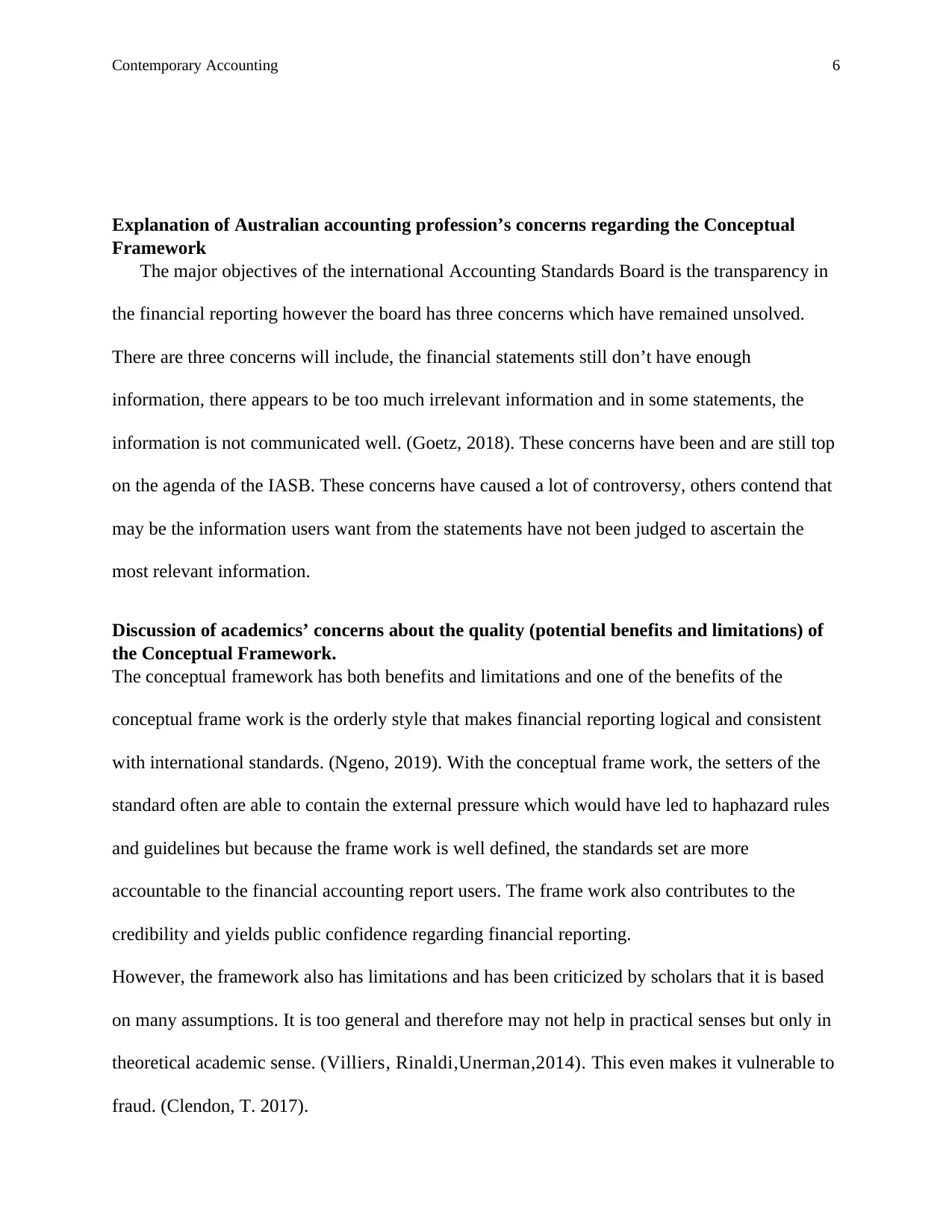
Contemporary Accounting 6
Explanation of Australian accounting profession’s concerns regarding the Conceptual
Framework
The major objectives of the international Accounting Standards Board is the transparency in
the financial reporting however the board has three concerns which have remained unsolved.
There are three concerns will include, the financial statements still don’t have enough
information, there appears to be too much irrelevant information and in some statements, the
information is not communicated well. (Goetz, 2018). These concerns have been and are still top
on the agenda of the IASB. These concerns have caused a lot of controversy, others contend that
may be the information users want from the statements have not been judged to ascertain the
most relevant information.
Discussion of academics’ concerns about the quality (potential benefits and limitations) of
the Conceptual Framework.
The conceptual framework has both benefits and limitations and one of the benefits of the
conceptual frame work is the orderly style that makes financial reporting logical and consistent
with international standards. (Ngeno, 2019). With the conceptual frame work, the setters of the
standard often are able to contain the external pressure which would have led to haphazard rules
and guidelines but because the frame work is well defined, the standards set are more
accountable to the financial accounting report users. The frame work also contributes to the
credibility and yields public confidence regarding financial reporting.
However, the framework also has limitations and has been criticized by scholars that it is based
on many assumptions. It is too general and therefore may not help in practical senses but only in
theoretical academic sense. (Villiers, Rinaldi,Unerman,2014). This even makes it vulnerable to
fraud. (Clendon, T. 2017).
Explanation of Australian accounting profession’s concerns regarding the Conceptual
Framework
The major objectives of the international Accounting Standards Board is the transparency in
the financial reporting however the board has three concerns which have remained unsolved.
There are three concerns will include, the financial statements still don’t have enough
information, there appears to be too much irrelevant information and in some statements, the
information is not communicated well. (Goetz, 2018). These concerns have been and are still top
on the agenda of the IASB. These concerns have caused a lot of controversy, others contend that
may be the information users want from the statements have not been judged to ascertain the
most relevant information.
Discussion of academics’ concerns about the quality (potential benefits and limitations) of
the Conceptual Framework.
The conceptual framework has both benefits and limitations and one of the benefits of the
conceptual frame work is the orderly style that makes financial reporting logical and consistent
with international standards. (Ngeno, 2019). With the conceptual frame work, the setters of the
standard often are able to contain the external pressure which would have led to haphazard rules
and guidelines but because the frame work is well defined, the standards set are more
accountable to the financial accounting report users. The frame work also contributes to the
credibility and yields public confidence regarding financial reporting.
However, the framework also has limitations and has been criticized by scholars that it is based
on many assumptions. It is too general and therefore may not help in practical senses but only in
theoretical academic sense. (Villiers, Rinaldi,Unerman,2014). This even makes it vulnerable to
fraud. (Clendon, T. 2017).
⊘ This is a preview!⊘
Do you want full access?
Subscribe today to unlock all pages.

Trusted by 1+ million students worldwide
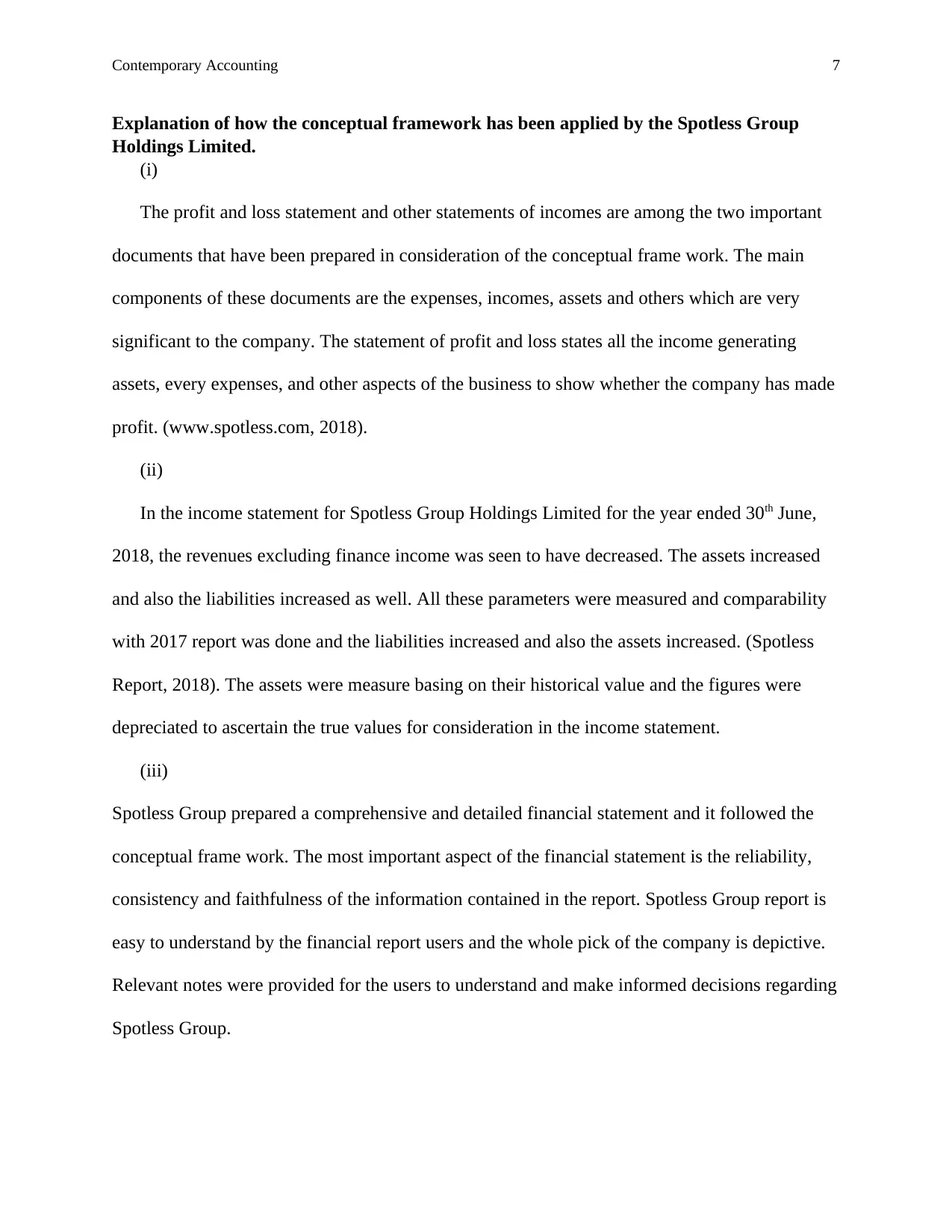
Contemporary Accounting 7
Explanation of how the conceptual framework has been applied by the Spotless Group
Holdings Limited.
(i)
The profit and loss statement and other statements of incomes are among the two important
documents that have been prepared in consideration of the conceptual frame work. The main
components of these documents are the expenses, incomes, assets and others which are very
significant to the company. The statement of profit and loss states all the income generating
assets, every expenses, and other aspects of the business to show whether the company has made
profit. (www.spotless.com, 2018).
(ii)
In the income statement for Spotless Group Holdings Limited for the year ended 30th June,
2018, the revenues excluding finance income was seen to have decreased. The assets increased
and also the liabilities increased as well. All these parameters were measured and comparability
with 2017 report was done and the liabilities increased and also the assets increased. (Spotless
Report, 2018). The assets were measure basing on their historical value and the figures were
depreciated to ascertain the true values for consideration in the income statement.
(iii)
Spotless Group prepared a comprehensive and detailed financial statement and it followed the
conceptual frame work. The most important aspect of the financial statement is the reliability,
consistency and faithfulness of the information contained in the report. Spotless Group report is
easy to understand by the financial report users and the whole pick of the company is depictive.
Relevant notes were provided for the users to understand and make informed decisions regarding
Spotless Group.
Explanation of how the conceptual framework has been applied by the Spotless Group
Holdings Limited.
(i)
The profit and loss statement and other statements of incomes are among the two important
documents that have been prepared in consideration of the conceptual frame work. The main
components of these documents are the expenses, incomes, assets and others which are very
significant to the company. The statement of profit and loss states all the income generating
assets, every expenses, and other aspects of the business to show whether the company has made
profit. (www.spotless.com, 2018).
(ii)
In the income statement for Spotless Group Holdings Limited for the year ended 30th June,
2018, the revenues excluding finance income was seen to have decreased. The assets increased
and also the liabilities increased as well. All these parameters were measured and comparability
with 2017 report was done and the liabilities increased and also the assets increased. (Spotless
Report, 2018). The assets were measure basing on their historical value and the figures were
depreciated to ascertain the true values for consideration in the income statement.
(iii)
Spotless Group prepared a comprehensive and detailed financial statement and it followed the
conceptual frame work. The most important aspect of the financial statement is the reliability,
consistency and faithfulness of the information contained in the report. Spotless Group report is
easy to understand by the financial report users and the whole pick of the company is depictive.
Relevant notes were provided for the users to understand and make informed decisions regarding
Spotless Group.
Paraphrase This Document
Need a fresh take? Get an instant paraphrase of this document with our AI Paraphraser
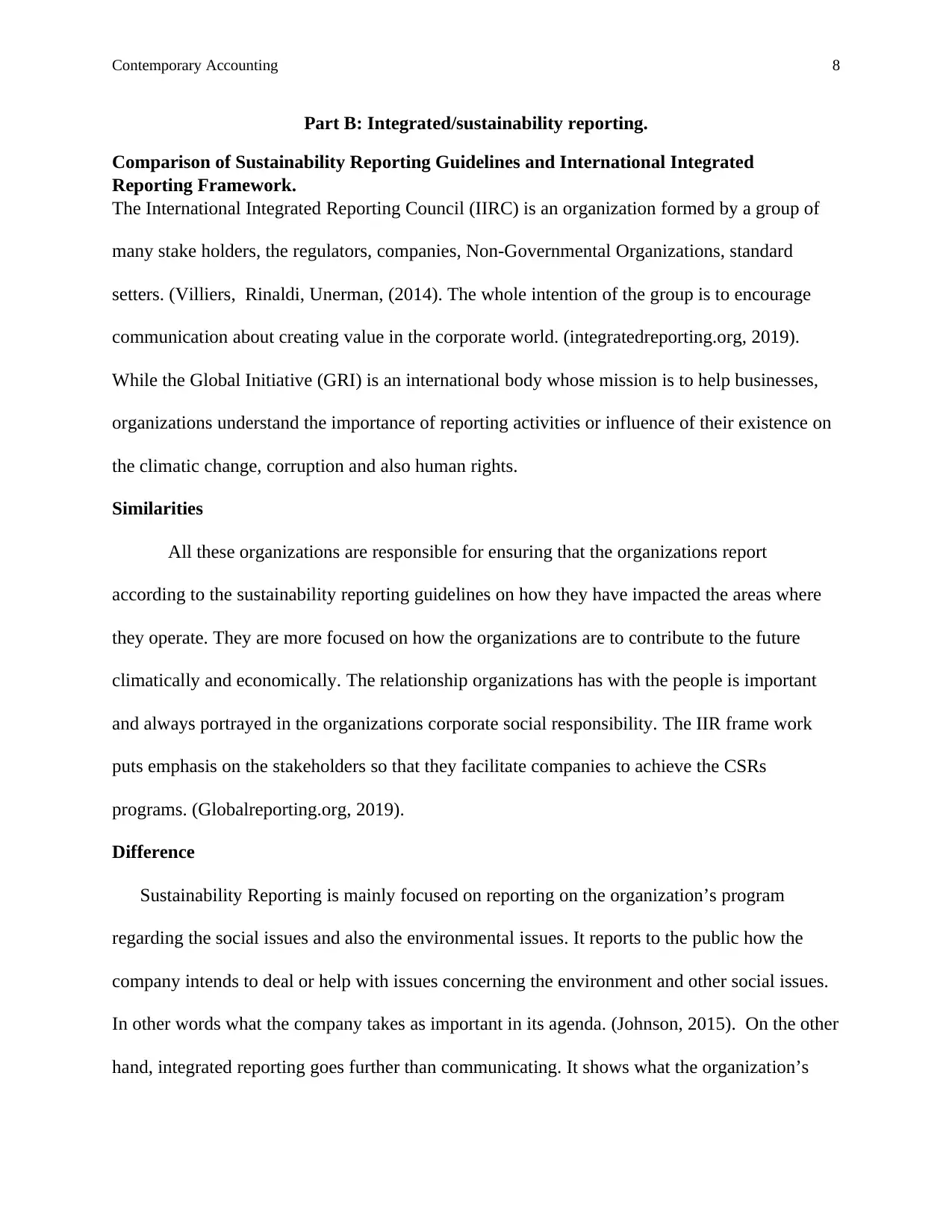
Contemporary Accounting 8
Part B: Integrated/sustainability reporting.
Comparison of Sustainability Reporting Guidelines and International Integrated
Reporting Framework.
The International Integrated Reporting Council (IIRC) is an organization formed by a group of
many stake holders, the regulators, companies, Non-Governmental Organizations, standard
setters. (Villiers, Rinaldi, Unerman, (2014). The whole intention of the group is to encourage
communication about creating value in the corporate world. (integratedreporting.org, 2019).
While the Global Initiative (GRI) is an international body whose mission is to help businesses,
organizations understand the importance of reporting activities or influence of their existence on
the climatic change, corruption and also human rights.
Similarities
All these organizations are responsible for ensuring that the organizations report
according to the sustainability reporting guidelines on how they have impacted the areas where
they operate. They are more focused on how the organizations are to contribute to the future
climatically and economically. The relationship organizations has with the people is important
and always portrayed in the organizations corporate social responsibility. The IIR frame work
puts emphasis on the stakeholders so that they facilitate companies to achieve the CSRs
programs. (Globalreporting.org, 2019).
Difference
Sustainability Reporting is mainly focused on reporting on the organization’s program
regarding the social issues and also the environmental issues. It reports to the public how the
company intends to deal or help with issues concerning the environment and other social issues.
In other words what the company takes as important in its agenda. (Johnson, 2015). On the other
hand, integrated reporting goes further than communicating. It shows what the organization’s
Part B: Integrated/sustainability reporting.
Comparison of Sustainability Reporting Guidelines and International Integrated
Reporting Framework.
The International Integrated Reporting Council (IIRC) is an organization formed by a group of
many stake holders, the regulators, companies, Non-Governmental Organizations, standard
setters. (Villiers, Rinaldi, Unerman, (2014). The whole intention of the group is to encourage
communication about creating value in the corporate world. (integratedreporting.org, 2019).
While the Global Initiative (GRI) is an international body whose mission is to help businesses,
organizations understand the importance of reporting activities or influence of their existence on
the climatic change, corruption and also human rights.
Similarities
All these organizations are responsible for ensuring that the organizations report
according to the sustainability reporting guidelines on how they have impacted the areas where
they operate. They are more focused on how the organizations are to contribute to the future
climatically and economically. The relationship organizations has with the people is important
and always portrayed in the organizations corporate social responsibility. The IIR frame work
puts emphasis on the stakeholders so that they facilitate companies to achieve the CSRs
programs. (Globalreporting.org, 2019).
Difference
Sustainability Reporting is mainly focused on reporting on the organization’s program
regarding the social issues and also the environmental issues. It reports to the public how the
company intends to deal or help with issues concerning the environment and other social issues.
In other words what the company takes as important in its agenda. (Johnson, 2015). On the other
hand, integrated reporting goes further than communicating. It shows what the organization’s
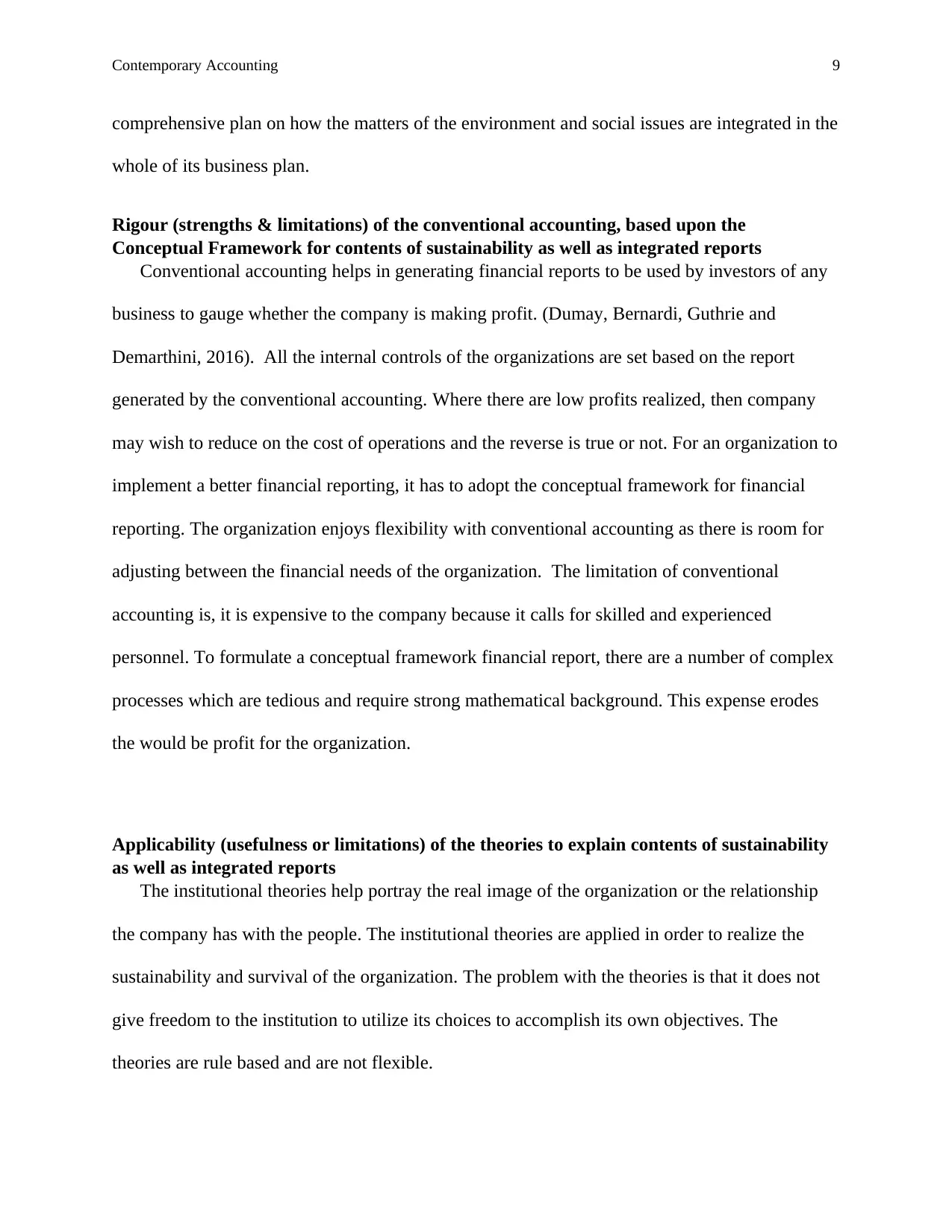
Contemporary Accounting 9
comprehensive plan on how the matters of the environment and social issues are integrated in the
whole of its business plan.
Rigour (strengths & limitations) of the conventional accounting, based upon the
Conceptual Framework for contents of sustainability as well as integrated reports
Conventional accounting helps in generating financial reports to be used by investors of any
business to gauge whether the company is making profit. (Dumay, Bernardi, Guthrie and
Demarthini, 2016). All the internal controls of the organizations are set based on the report
generated by the conventional accounting. Where there are low profits realized, then company
may wish to reduce on the cost of operations and the reverse is true or not. For an organization to
implement a better financial reporting, it has to adopt the conceptual framework for financial
reporting. The organization enjoys flexibility with conventional accounting as there is room for
adjusting between the financial needs of the organization. The limitation of conventional
accounting is, it is expensive to the company because it calls for skilled and experienced
personnel. To formulate a conceptual framework financial report, there are a number of complex
processes which are tedious and require strong mathematical background. This expense erodes
the would be profit for the organization.
Applicability (usefulness or limitations) of the theories to explain contents of sustainability
as well as integrated reports
The institutional theories help portray the real image of the organization or the relationship
the company has with the people. The institutional theories are applied in order to realize the
sustainability and survival of the organization. The problem with the theories is that it does not
give freedom to the institution to utilize its choices to accomplish its own objectives. The
theories are rule based and are not flexible.
comprehensive plan on how the matters of the environment and social issues are integrated in the
whole of its business plan.
Rigour (strengths & limitations) of the conventional accounting, based upon the
Conceptual Framework for contents of sustainability as well as integrated reports
Conventional accounting helps in generating financial reports to be used by investors of any
business to gauge whether the company is making profit. (Dumay, Bernardi, Guthrie and
Demarthini, 2016). All the internal controls of the organizations are set based on the report
generated by the conventional accounting. Where there are low profits realized, then company
may wish to reduce on the cost of operations and the reverse is true or not. For an organization to
implement a better financial reporting, it has to adopt the conceptual framework for financial
reporting. The organization enjoys flexibility with conventional accounting as there is room for
adjusting between the financial needs of the organization. The limitation of conventional
accounting is, it is expensive to the company because it calls for skilled and experienced
personnel. To formulate a conceptual framework financial report, there are a number of complex
processes which are tedious and require strong mathematical background. This expense erodes
the would be profit for the organization.
Applicability (usefulness or limitations) of the theories to explain contents of sustainability
as well as integrated reports
The institutional theories help portray the real image of the organization or the relationship
the company has with the people. The institutional theories are applied in order to realize the
sustainability and survival of the organization. The problem with the theories is that it does not
give freedom to the institution to utilize its choices to accomplish its own objectives. The
theories are rule based and are not flexible.
⊘ This is a preview!⊘
Do you want full access?
Subscribe today to unlock all pages.

Trusted by 1+ million students worldwide
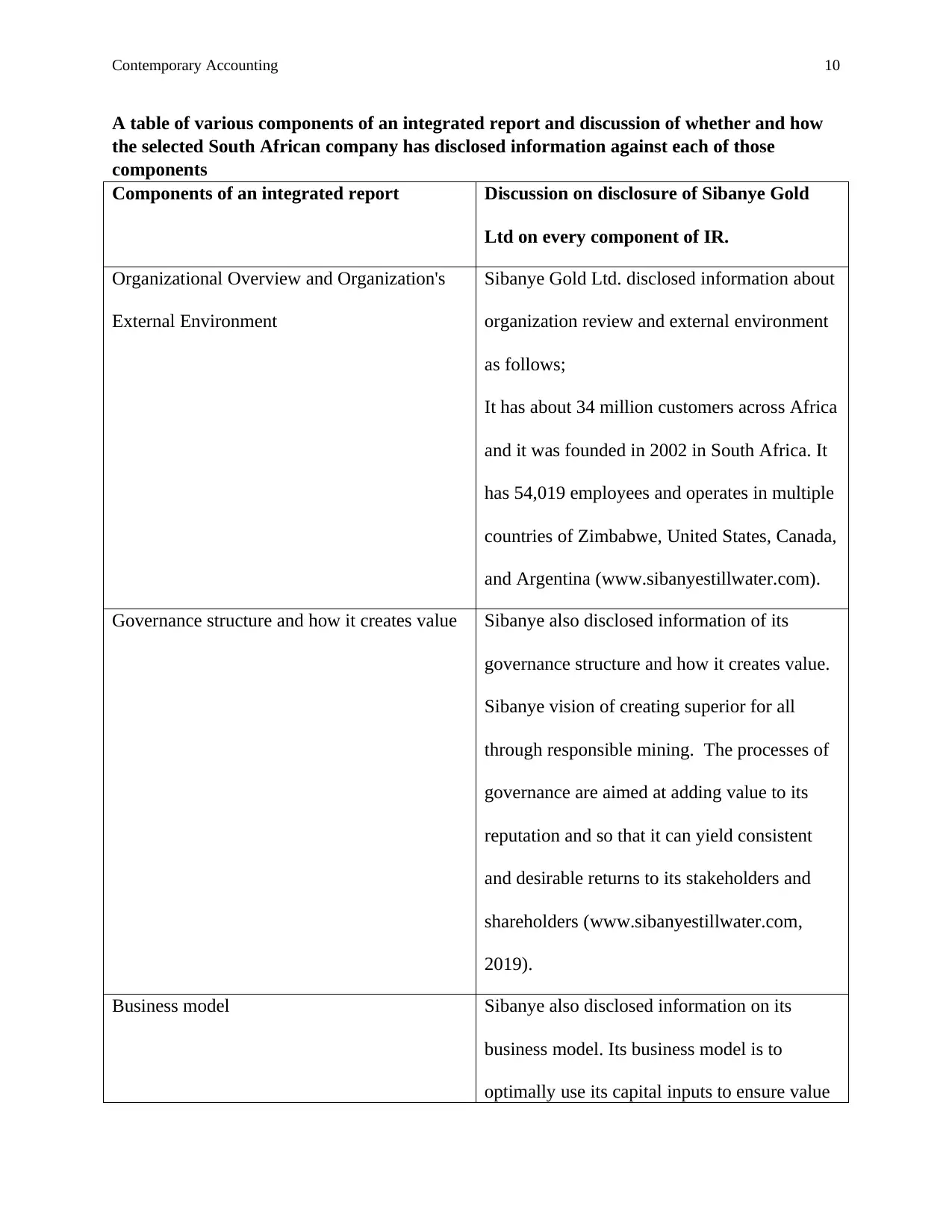
Contemporary Accounting 10
A table of various components of an integrated report and discussion of whether and how
the selected South African company has disclosed information against each of those
components
Components of an integrated report Discussion on disclosure of Sibanye Gold
Ltd on every component of IR.
Organizational Overview and Organization's
External Environment
Sibanye Gold Ltd. disclosed information about
organization review and external environment
as follows;
It has about 34 million customers across Africa
and it was founded in 2002 in South Africa. It
has 54,019 employees and operates in multiple
countries of Zimbabwe, United States, Canada,
and Argentina (www.sibanyestillwater.com).
Governance structure and how it creates value Sibanye also disclosed information of its
governance structure and how it creates value.
Sibanye vision of creating superior for all
through responsible mining. The processes of
governance are aimed at adding value to its
reputation and so that it can yield consistent
and desirable returns to its stakeholders and
shareholders (www.sibanyestillwater.com,
2019).
Business model Sibanye also disclosed information on its
business model. Its business model is to
optimally use its capital inputs to ensure value
A table of various components of an integrated report and discussion of whether and how
the selected South African company has disclosed information against each of those
components
Components of an integrated report Discussion on disclosure of Sibanye Gold
Ltd on every component of IR.
Organizational Overview and Organization's
External Environment
Sibanye Gold Ltd. disclosed information about
organization review and external environment
as follows;
It has about 34 million customers across Africa
and it was founded in 2002 in South Africa. It
has 54,019 employees and operates in multiple
countries of Zimbabwe, United States, Canada,
and Argentina (www.sibanyestillwater.com).
Governance structure and how it creates value Sibanye also disclosed information of its
governance structure and how it creates value.
Sibanye vision of creating superior for all
through responsible mining. The processes of
governance are aimed at adding value to its
reputation and so that it can yield consistent
and desirable returns to its stakeholders and
shareholders (www.sibanyestillwater.com,
2019).
Business model Sibanye also disclosed information on its
business model. Its business model is to
optimally use its capital inputs to ensure value
Paraphrase This Document
Need a fresh take? Get an instant paraphrase of this document with our AI Paraphraser
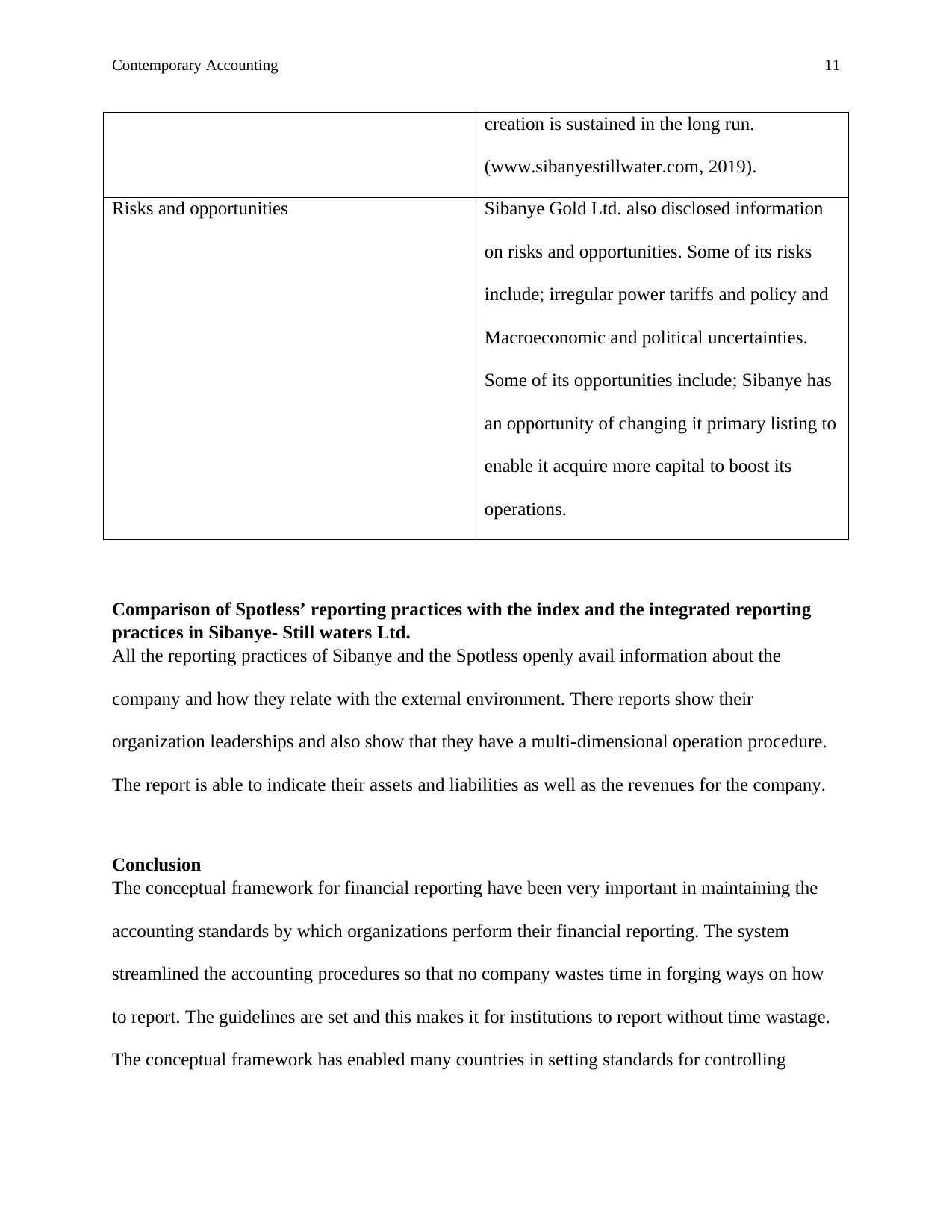
Contemporary Accounting 11
creation is sustained in the long run.
(www.sibanyestillwater.com, 2019).
Risks and opportunities Sibanye Gold Ltd. also disclosed information
on risks and opportunities. Some of its risks
include; irregular power tariffs and policy and
Macroeconomic and political uncertainties.
Some of its opportunities include; Sibanye has
an opportunity of changing it primary listing to
enable it acquire more capital to boost its
operations.
Comparison of Spotless’ reporting practices with the index and the integrated reporting
practices in Sibanye- Still waters Ltd.
All the reporting practices of Sibanye and the Spotless openly avail information about the
company and how they relate with the external environment. There reports show their
organization leaderships and also show that they have a multi-dimensional operation procedure.
The report is able to indicate their assets and liabilities as well as the revenues for the company.
Conclusion
The conceptual framework for financial reporting have been very important in maintaining the
accounting standards by which organizations perform their financial reporting. The system
streamlined the accounting procedures so that no company wastes time in forging ways on how
to report. The guidelines are set and this makes it for institutions to report without time wastage.
The conceptual framework has enabled many countries in setting standards for controlling
creation is sustained in the long run.
(www.sibanyestillwater.com, 2019).
Risks and opportunities Sibanye Gold Ltd. also disclosed information
on risks and opportunities. Some of its risks
include; irregular power tariffs and policy and
Macroeconomic and political uncertainties.
Some of its opportunities include; Sibanye has
an opportunity of changing it primary listing to
enable it acquire more capital to boost its
operations.
Comparison of Spotless’ reporting practices with the index and the integrated reporting
practices in Sibanye- Still waters Ltd.
All the reporting practices of Sibanye and the Spotless openly avail information about the
company and how they relate with the external environment. There reports show their
organization leaderships and also show that they have a multi-dimensional operation procedure.
The report is able to indicate their assets and liabilities as well as the revenues for the company.
Conclusion
The conceptual framework for financial reporting have been very important in maintaining the
accounting standards by which organizations perform their financial reporting. The system
streamlined the accounting procedures so that no company wastes time in forging ways on how
to report. The guidelines are set and this makes it for institutions to report without time wastage.
The conceptual framework has enabled many countries in setting standards for controlling
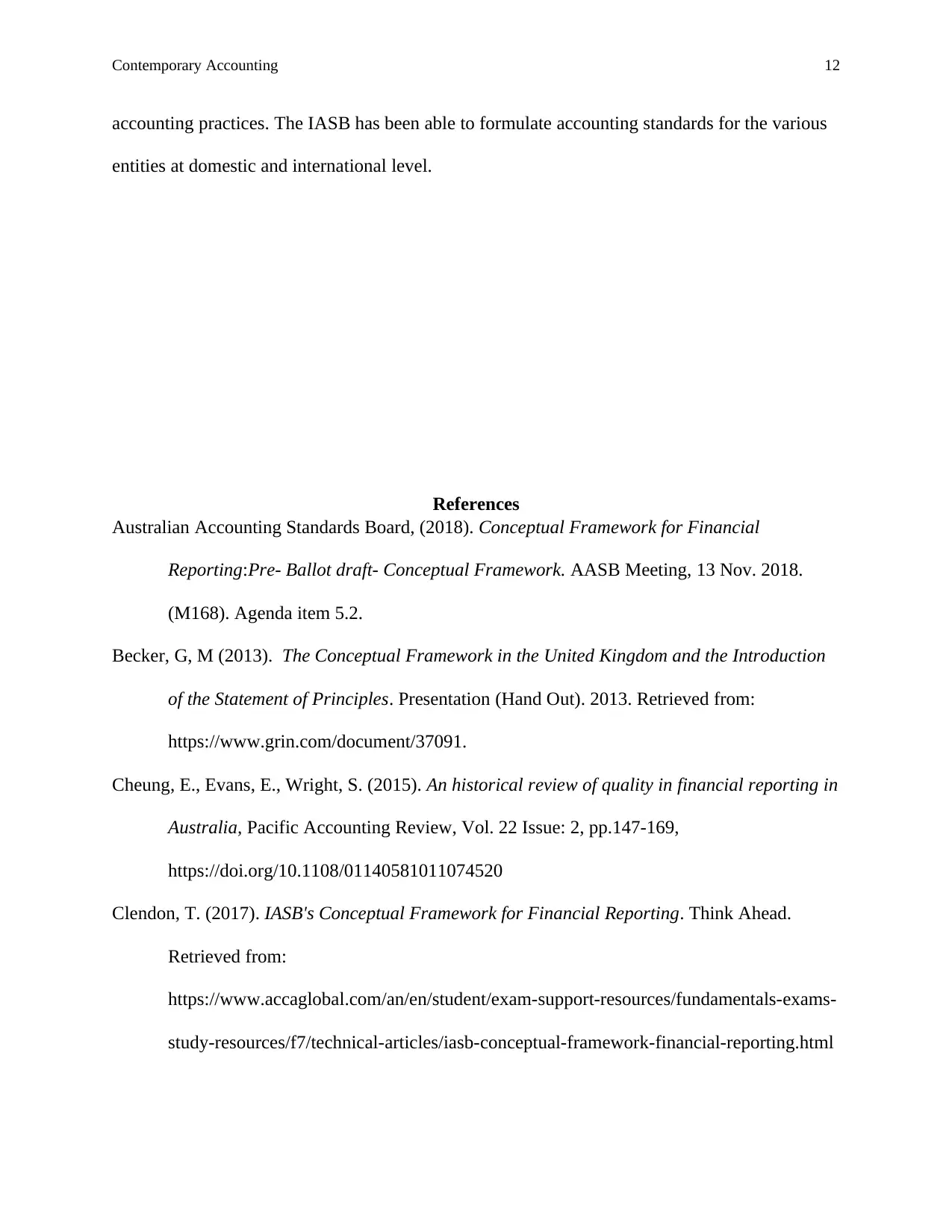
Contemporary Accounting 12
accounting practices. The IASB has been able to formulate accounting standards for the various
entities at domestic and international level.
References
Australian Accounting Standards Board, (2018). Conceptual Framework for Financial
Reporting:Pre- Ballot draft- Conceptual Framework. AASB Meeting, 13 Nov. 2018.
(M168). Agenda item 5.2.
Becker, G, M (2013). The Conceptual Framework in the United Kingdom and the Introduction
of the Statement of Principles. Presentation (Hand Out). 2013. Retrieved from:
https://www.grin.com/document/37091.
Cheung, E., Evans, E., Wright, S. (2015). An historical review of quality in financial reporting in
Australia, Pacific Accounting Review, Vol. 22 Issue: 2, pp.147-169,
https://doi.org/10.1108/01140581011074520
Clendon, T. (2017). IASB's Conceptual Framework for Financial Reporting. Think Ahead.
Retrieved from:
https://www.accaglobal.com/an/en/student/exam-support-resources/fundamentals-exams-
study-resources/f7/technical-articles/iasb-conceptual-framework-financial-reporting.html
accounting practices. The IASB has been able to formulate accounting standards for the various
entities at domestic and international level.
References
Australian Accounting Standards Board, (2018). Conceptual Framework for Financial
Reporting:Pre- Ballot draft- Conceptual Framework. AASB Meeting, 13 Nov. 2018.
(M168). Agenda item 5.2.
Becker, G, M (2013). The Conceptual Framework in the United Kingdom and the Introduction
of the Statement of Principles. Presentation (Hand Out). 2013. Retrieved from:
https://www.grin.com/document/37091.
Cheung, E., Evans, E., Wright, S. (2015). An historical review of quality in financial reporting in
Australia, Pacific Accounting Review, Vol. 22 Issue: 2, pp.147-169,
https://doi.org/10.1108/01140581011074520
Clendon, T. (2017). IASB's Conceptual Framework for Financial Reporting. Think Ahead.
Retrieved from:
https://www.accaglobal.com/an/en/student/exam-support-resources/fundamentals-exams-
study-resources/f7/technical-articles/iasb-conceptual-framework-financial-reporting.html
⊘ This is a preview!⊘
Do you want full access?
Subscribe today to unlock all pages.

Trusted by 1+ million students worldwide
1 out of 14
Related Documents
Your All-in-One AI-Powered Toolkit for Academic Success.
+13062052269
info@desklib.com
Available 24*7 on WhatsApp / Email
![[object Object]](/_next/static/media/star-bottom.7253800d.svg)
Unlock your academic potential
Copyright © 2020–2025 A2Z Services. All Rights Reserved. Developed and managed by ZUCOL.





